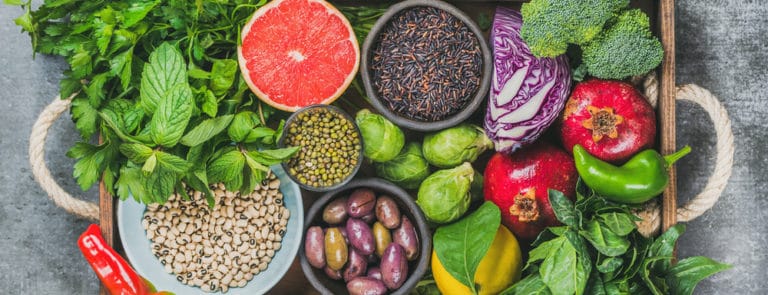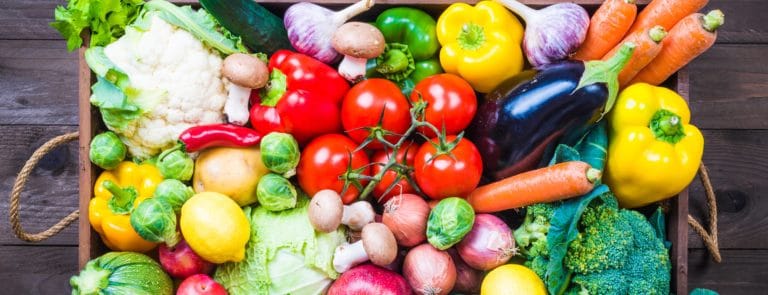15% off £35 OR 20% off £45
Eating seasonal foods- seasonal fruits & vegetables benefits

You may or may not have heard the call to ‘eat seasonally’.
In a world of 24-hour supermarkets, where the shelves are stocked with produce from every corner of the world every single day, it can be easy to forget about how and when things grow.
After all, our favourite fruits and vegetables always seem to be there and ready for us to pop in the trolley.
But did you know there are some huge benefits to eating with the seasons?
What does eating in season mean?
The concept of eating seasonally is actually really simple. It involves eating foods that are grown at the same time as you eat them.
As most fruits and vegetables are being grown somewhere in the world at any one time, eating seasonally more specifically concerns eating produce that’s being grown right now - locally.
The main aim of this? To minimise the time it takes for the fresh produce you buy to get from the ground or the tree to your plate.
6 benefits of eating seasonal foods
If you are on the fence as to whether or not you should start eating seasonally, check out some of our top benefits below.
-
It saves you money
First and foremost, eating seasonally could keep your wallet heavier.
When fruits and vegetables are out of season in your area, they either have to be grown in managed conditions or transported from the other side of the world.
Both of these processes cost lots of money, and that cost gets passed on to you – the consumer.
When you eat seasonally, local produce can be grown in natural conditions and easily transported to the point of sale, making it much more affordable.
-
It tastes better
You’d be surprised how far some foods have to travel to ensure they’re on the shelves 365 days a year.
Out of season fruit and veg can spend days and weeks travelling to get to you, and this comes with a price.
Either they’re picked earlier than they should be so that they’re ready on arrival, or they spoil a little on the way. Whichever happens – flavour and freshness are compromised on-route.
Seasonal produce comes such a short distance that it doesn’t spoil on the way to you. It’s harvested at the very best time, so taste is maximised.
-
It’s healthier
For the same reason, seasonal fruit and veg taste better, it’s also healthier.
It’s no surprise that being locked in cargo holds and shipping containers for days, in order to reach us, does nothing for the nutritional content of the food.
In fact, in many cases it’s detrimental.
As a rule of thumb; the fresher the better, and you can’t get much fresher than eating seasonally-grown local produce.
-
It supports your local community
When you buy foods out of season, the profits are swallowed up by the grower, the transporter and the retailer – and it’s a safe bet that none of these are based in your local area.
Growers in your region don’t down tools out of season; they’ll be churning out fruit and veg all year round.
By buying what they produce, you’ll constantly be feeding the profits back into your own community.
-
It’s kinder to the planet
Be it by plane, train or automobile – when food has to come a long way to get to you, it comes with a carbon footprint.
Of course, every apple you buy has had a journey to get to the store.
It’s a safe bet that the apple that’s come from a farm 50 miles away as it’s in season here, compared with one that’s had to come from South Africa, has had a more environmentally-friendly and sustainable trip.
-
It’s exciting!
When you make a concerted effort to eat seasonally, you’ll find yourself introduced to foods and dishes that you may not have considered before.
It’s often said that limitation is the key to creativity; who knows what meals you might end up rustling up. As the seasons change, you’ll get plenty of variety in your diet too.
How can I eat seasonally?
Working out what’s seasonal in your area might seem difficult, but it’s easier than you think.
9 ways to eat seasonal foods
- Keep an eye on prices in the supermarkets – if they’re falling it’s a good sign that that food is coming into season, while high prices suggest it’s out of season.
- Farmers markets are a great way to get your hands on quality local produce. You’ll be buying directly from your area, and there’s usually bargains to be found.
- Make a seasonal food calendar use the information below to plan what fruits and vegetables to buy. This also helps you to plan ahead with meals as well as shopping.
- Get foraging – wild nettles, wild garlic and other naturally occurring foods are ripe for the picking in woodland and country hedgerow – just make sure you give them a good clean.
- Grow your own – the best way to eat seasonally? Grow your own! Herbs and lettuce is a good place to start as it can been grown indoors or out easily, only requiring a little space.
- Preserve fresh food – preserving food like cabbage by making kimchi or sauerkraut, or pickling other veg is a great way to enjoy foods at their best, even when they’re not in season.
- Make jam – transforming fresh berries into jams and preserves is another great way to enjoy fruit at its tastiest for longest.
- Join a group – find a local seasonal eating group or one online to get support and tips.
- Visit farm to table restaurants, because sometimes you don’t fancy cooking or have something to celebrate, and this is one of the best ways to do it while keeping your seasonal eating on track.
For great ideas on how to prepare your seasonal fruit and veg, check out some of our delicious recipes.
What are seasonal foods in the UK?
To help you out on your seasonal eating journey, here is a month to month guide on the fruits and vegetables you should eat every month in the UK.1
What are seasonal fruits in the UK?
Here are the fruits you should buy every month in the UK.2
| Month | Seasonal fruit |
|---|---|
| January |
Apples and pears |
| February |
Apples and pears |
| March |
Rhubarb |
| April |
Rhubarb |
| May |
Rhubarb and strawberries |
| June |
Blackcurrants, gooseberries, raspberries, redcurrants, rhubarb, strawberries and tayberries |
| July |
Blackberries, blackcurrants, blueberries, cherries, gooseberries, raspberries, redcurrants, rhubarb and strawberries |
| August |
Blackberries, blackcurrants, cherries, loganberries, plums, raspberries, redcurrants, rhubarb and strawberries |
| September |
Blackberries, raspberries, rhubarb and strawberries |
| October |
Apples, blackberries, elderberries and pears |
| November |
Apples, cranberries, elderberries and pears |
| December |
Apples and pears |
What are seasonal vegetables in the UK?
Here are the vegetables you should buy every month in the UK.3
| Month | Seasonal vegetables |
|---|---|
| January |
Beetroot, brussels sprouts, carrots, celeriac, celery, chicory, Jerusalem artichokes, kale, leeks, mushrooms, onions, parsnips, red cabbage, salsify, savoy cabbage, spring greens, spring onions, squash, swedes, turnips and white cabbage |
| February |
Beetroot, brussels sprouts, carrots, celeriac, chicory, Jerusalem artichokes, kale, leeks, mushrooms, onions, parsnips, purple sprouting broccoli, red cabbage, salsify, savoy cabbage, spring greens, spring onions, squash, swedes and white cabbage |
| March |
Artichoke, beetroot, carrots, chicory, cucumber, leeks, parsnip, purple sprouting broccoli, radishes, sorrel, spring greens, spring onions and watercress |
| April |
Artichoke, beetroot, carrots, chicory, new potatoes, kale, morel mushrooms, parsnips, radishes, rocket, sorrel, spinach, spring greens, spring onions and watercress |
| May |
Artichoke, asparagus, aubergine, beetroot, chicory, chillies, lettuce, marrow, new potatoes, peas, peppers, radishes, rocket, samphire, sorrel, spinach, spring greens, spring onions, sweetheart cabbage and watercress |
| June |
Asparagus, aubergine, beetroot, broad beans, broccoli, cauliflower, chicory, chillies, courgettes, cucumber, lettuce, marrow, new potatoes, peas, peppers, radishes, rocket, runner beans, samphire, sorrel, spring onions, summer squash, sweetheart cabbage, swiss chard, turnips and watercress |
| July |
Aubergine, beetroot, broad beans, broccoli, carrots, cauliflower, chicory, chillies, courgettes, cucumber, greengages, fennel, french beans, garlic, kohlrabi, new potatoes, onions, peas, potatoes, radishes, rocket, runner beans, samphire, sorrel, spring greens, spring onions, summer squash, sweetheart cabbage, swiss chard, tomatoes, turnips and watercress |
| August |
Aubergine, beetroot, broad beans, broccoli, carrots, cauliflower, chicory, chillies, courgettes, cucumber, fennel, french beans, garlic, greengages, kohlrabi, leeks, lettuce, mangetout, marrow, mushrooms, parsnips, peas, peppers, potatoes, pumpkin, radishes, rocket, runner beans, samphire, sorrel, spring greens, spring onions, summer squash, sweetcorn, sweetheart cabbage, swiss chard, tomatoes, watercress and white cabbage |
| September |
Aubergine, beetroot, broccoli, brussels sprouts, butternut squash, carrots, cauliflower, celery, courgettes, chicory, chillies, cucumber, garlic, kale, kohlrabi, leeks, lettuce, mangetout, marrow, onions, parsnips, peas, peppers, potatoes, pumpkin, radishes, red cabbage, rocket, runner beans, samphire, sorrel, spinach, spring greens, spring onions, summer squash, sweetcorn, sweetheart cabbage, swiss chard, tomatoes, turnips, watercress, wild mushrooms and white cabbage |
| October |
Aubergine, beetroot, broccoli, brussels sprouts, butternut squash, carrots, cauliflower, celeriac, celery, chestnuts, chicory, chillies, courgette, cucumber, kale, leeks, lettuce, marrow, onions, parsnips, peas, potatoes, pumpkin, quince, radishes, red cabbage, rocket, runner beans, salsify, savoy cabbage, spinach, spring greens, spring onions, summer squash, swede, sweetcorn, sweetheart cabbage, swiss chard, tomatoes, turnips, watercress, wild mushrooms, winter squash and white cabbage |
| November |
Brussels sprouts, butternut squash, carrots, cauliflower, celeriac, celery, chestnuts, chicory, Jerusalem artichokes, kale, leeks, onions, parsnips, potatoes, pumpkin, quince, red cabbage, salsify, savoy cabbage, swede, swiss chard, turnips, watercress, wild mushrooms, winter squash and white cabbage |
| December |
Beetroot, brussels sprouts, carrots, celeriac, celery, chestnuts, chicory, Jerusalem artichokes, kale, leeks, mushrooms, onions, parsnips, potatoes, pumpkin, quince, red cabbage, salsify, savoy cabbage, swede, swiss chard, turnips, watercress, winter squash and white cabbage |
Are there any disadvantages to eating seasonally?
Disadvantages of seasonal foods are few and far between, but the following factors are something you should be aware of:
- Shopping may seem limited
- You will have to plan more at first
- It may take more time at first
But we think the advantages outweigh the disadvantages!
Are seasonal foods suitable for everyone?
Yes! If anything, seasonal foods are more suitable for most, especially if you’re trying to save money or improve your health.
They may not be suitable for those with not a lot of spare time to be cooking / planning though, although it gets easier with time.
The final say
- Eating in season means eating food that grows naturally at a certain time of year where you live, instead of eating foods imported from other countries
- Eating seasonally can help you save money, tastes better, is better for the local community and has tons of other benefits
- Visiting farmers markets, making a seasonal food calendar and growing your own fruits and vegetables can help support seasonal eating
- You do have to do some extra planning and probably some extra cooking, so it’s worth keeping that in mind when you first start out – but it’s accessible for a lot of people as local fresh food is often cheapest
How many portions of fruit and veg a day?
How many portions of fruit and veg a day?
Wondering how many portions of fruit and veg we should eat a day? And how big the portion sizes are? We can help with that.
Read more


Last updated: 29 September 2021













